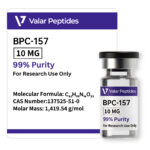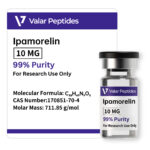
BPC-157 10mg

Comprehensive guide to peptide properties, storage, handling, and research applications for scientific excellence.
Basic peptide structure and function
Proper storage and handling protocols
How to properly reconstitute peptides
Testing and verification methods
Common research uses and protocols
Laboratory safety and compliance
Peptides are short chains of amino acids linked by peptide bonds, typically containing 2-50 amino acid residues. They are naturally occurring biological molecules that play crucial roles in various physiological processes, including hormone regulation, immune function, and cellular signaling.
Straight chains of amino acids with free N- and C-termini
Circular structures formed by disulfide bonds or backbone cyclization
Peptides with chemical modifications for enhanced stability
Peptides linked to other molecules like lipids or carbohydrates
Proper storage and handling are critical for maintaining peptide integrity and ensuring reliable research results. Follow these guidelines to preserve peptide quality throughout your research.
| Storage Type | Temperature | Duration | Notes |
|---|---|---|---|
| Long-term | -80°C | 2-3 years | Optimal for long-term storage |
| Standard | -20°C | 1-2 years | Most common storage condition |
| Short-term | 4°C | 1-2 weeks | For immediate use only |
| Working solution | 4°C | 1-7 days | Reconstituted peptides |
Proper reconstitution is essential for peptide stability and biological activity. Follow these step-by-step protocols to ensure optimal results in your research.
Peptides serve as valuable research tools across multiple scientific disciplines. Understanding their applications helps researchers select appropriate peptides for their specific studies.
All peptides are for research use only. NOT for human consumption. Follow all institutional safety protocols and regulatory guidelines when handling research materials.
Our scientific support team is available to help with peptide selection, protocols, and technical questions.

